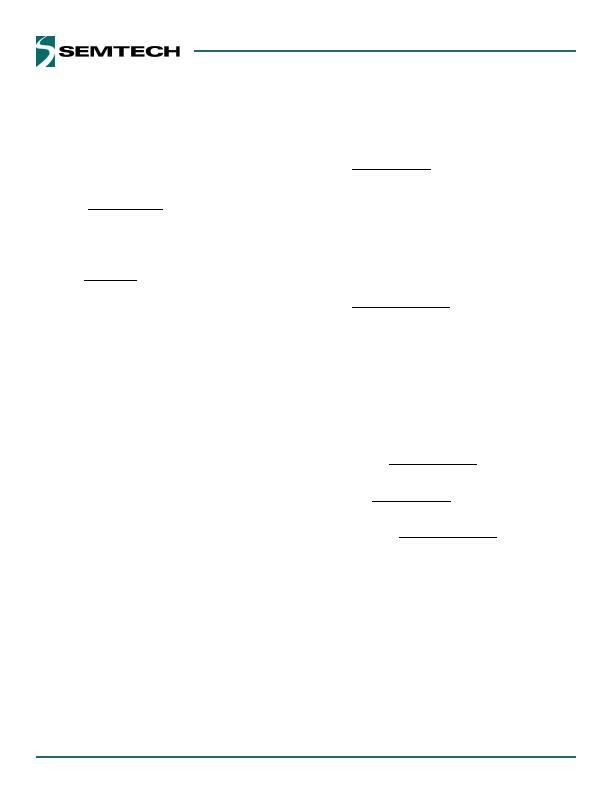
SC417/SC427
24
Applications Information (continued)
The desired switching frequency is 250kHz which results
from using components selected for optimum size and
cost.
A resistor (R
TON
) is used to program the on-time (indirectly
setting the frequency) using the following equation.
T
IN
ON
TON
V
pF
25
V
)
ns
10
T
(
R
To select R
TON
, use the maximum value for V
IN
, and for T
ON
use the value associated with maximum V
IN
.
W
INMAX
OUT
ON
f
V
V
T
T
ON
= 318 ns at 13.2V
IN
, 1.05V
OUT
, 250kHz
Substituting for R
TON
results in the following solution.
R
TON
= 154.9k&, use R
TON
= 154k&
Inductor Selection
In order to determine the inductance, the ripple current
must first be defined. Low inductor values result in smaller
size but create higher ripple current which can reduce
efficiency. Higher inductor values will reduce the ripple
current/voltage and for a given DC resistance are more
efficient. However, larger inductance translates directly
into larger packages and higher cost. Cost, size, output
ripple, and efficiency are all used in the selection process.
The ripple current will also set the boundary for power-
save operation. The switching will typically enter power-
save mode when the load current decreases to 1/2 of the
ripple current. For example, if ripple current is 4A then
Power-save operation will typically start for loads less than
2A. If ripple current is set at 40% of maximum load current,
then power-save will start for loads less than 20% of
maximum current.
The inductor value is typically selected to provide a ripple
current that is between 25% to 50% of the maximum load
current. This provides an optimal trade-off between cost,
efficiency, and transient performance.
During the DH on-time, voltage across the inductor is
(V
IN
- V
OUT
). The equation for determining inductance is
shown next.
ON
OUT
IN
I
T
)
V
V
(
L
Example
In this example, the inductor ripple current is set equal to
50% of the maximum load current. Therefore ripple
current will be 50% x 10A or 5A. To find the minimum
inductance needed, use the V
IN
and T
ON
values that corre-
spond to V
INMAX
.
H
77
.
0
A
5
ns
318
)
05
.
1
2
.
13
(
L
A slightly larger value of 0.88礖 is selected. This will
decrease the maximum I
RIPPLE
to 4.4A.
Note that the inductor must be rated for the maximum DC
load current plus 1/2 of the ripple current.
The ripple current under minimum V
IN
conditions is also
checked using the following equations.
ns
384
ns
10
V
V
R
pF
25
T
INMIN
OUT
TON
VINMIN
_
ON
L
T
)
V
V
(
I
ON
OUT
IN
RIPPLE
A
25
.
4
H
088
ns
384
)
05
.
1
8
.
10
(
I
VINMIN
_
RIPPLE
Output Capacitor Selection
The output capacitors are chosen based on required ESR
and capacitance. The maximum ESR requirement is con-
trolled by the output ripple requirement and the DC toler-
ance. The output voltage has a DC value that is equal to
the valley of the output ripple plus 1/2 of the peak-to-peak
ripple. Change in the output ripple voltage will lead to a
change in DC voltage at the output.
The design goal is that the output voltage regulation be
?% under static conditions. The internal 500mV refer-
ence tolerance is 1%. Allowing 1% tolerance from the FB
resistor divider, this allows 2% tolerance due to V
OUT
ripple.
发布紧急采购,3分钟左右您将得到回复。
相关PDF资料
SE95D,112
IC SENSOR TEMP 2.8-5.5V SOT96-1
SE97BTP,547
IC TEMP SENSOR DIMM 8HWSON
SE98ATP,547
IC TEMP SENSOR DDR 8-HWSON
SG6901ASZ
IC PFC CTLR AVERAGE CURR 20SOIC
SG6932SZ
IC PFC CONTROLLER CCM 16SOP
SG6961SY
IC PFC CTRLR AVERAGE CURR 8SOIC
SI3500-A-GM
IC POE SWITCH PWR OVER LAN 20QFN
SI786LSG-E3
IC REG QD BUCK/LINEAR 28SSOP
相关代理商/技术参数
SC428
制造商:Mallory 功能描述:Sonalert
SC4-28
功能描述:SCREW 4-40 HEX .5"L FOR CONN MNT RoHS:是 类别:盒,外壳,支架 >> 卡架 - 配件 系列:VectorPak™ 标准包装:1 系列:VectorPak™ 附件类型:EFP 模块 适用于相关产品:PCB
SC428312CFGE
制造商:Freescale Semiconductor 功能描述:
SC42920FNR2
制造商:Motorola Inc 功能描述:
SC430769CFNER
制造商:Freescale Semiconductor 功能描述:SMOKE DETECTOR
SC430770CFNER
制造商:Freescale Semiconductor 功能描述:HEAT DETECTOR
SC431
制造商:SEMTECH 制造商全称:Semtech Corporation 功能描述:ADJUSTABLE SHUNT REGULATOR
SC431_05
制造商:SEMTECH 制造商全称:Semtech Corporation 功能描述:Adjustable Shunt Regulator
